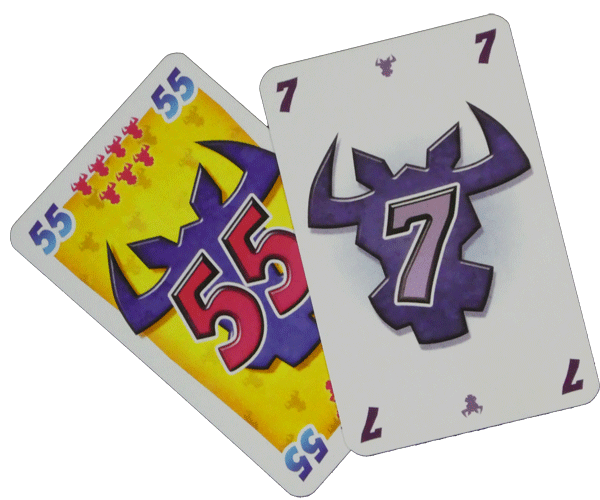
An uncomplicated game using a set of cards numbered 1 to 104. The aim is to avoid collecting any cards, since every card you take gives you penalty points – shown as bulls’ heads (top & bottom of the cards).
Players want to accumulate as few points as possible.
Most cards carry one penalty point: others range from three to seven!
Each player is dealt ten cards, and four are laid face up, becoming the starting cards for the round – each forms the start of a row, which everbody uses.
Each row is permitted hold up to five cards, and no more. All players firstly and secretly choose one card to play (laying it face down), hoping to add it safely to the end of one of the four rows on display.
Once all have chosen, their cards are revealed simultaneously.
Beginning with the player who played the card with the lowest value, cards are added to the four rows, following two very strict but very simple rules. The main one is that cards must be placed in ascending order based on their value.
The other rule is that if they could go in more than one row, because their number is higher, cards must be placed at the end of the row whose current highest card is closest to their new card.

If a row gets to a point where the next card to join it would make six the player has to pick up the whole row, along with bulls’ head penalties. These cards show 8 bulls’ heads.
6 Nimmt! in English means 6, Take!
► If the lowest card that’s played is lower than all the currently-showing highest cards, that player must choose a row to pick up, leaving their low card on the table as the start of a new row.
Each round takes up the 10 cards that were dealt out. When they’re expended, all the cards are gathered together for a new round, with 4 new starter cards.
When someone accumulates 66 bulls’ heads it signals the end of the game – which comes at the conclusion of the current round.
People may not catch on instantly to the idea of deliberately not winning cards, easy though it seems – so the game may feel more complicated than it really is. Doing so in the face of competition from others who also are trying hard to not win can make for an exciting and unpredictable game.
- not winning takes a little getting used to …
- no setting up
- replayable
- calls for strategic thinking – delayed action
- somewhat combative, “quietly”
- luck is involved – what 10 cards will you be landed with?
- may be best with five or six players
